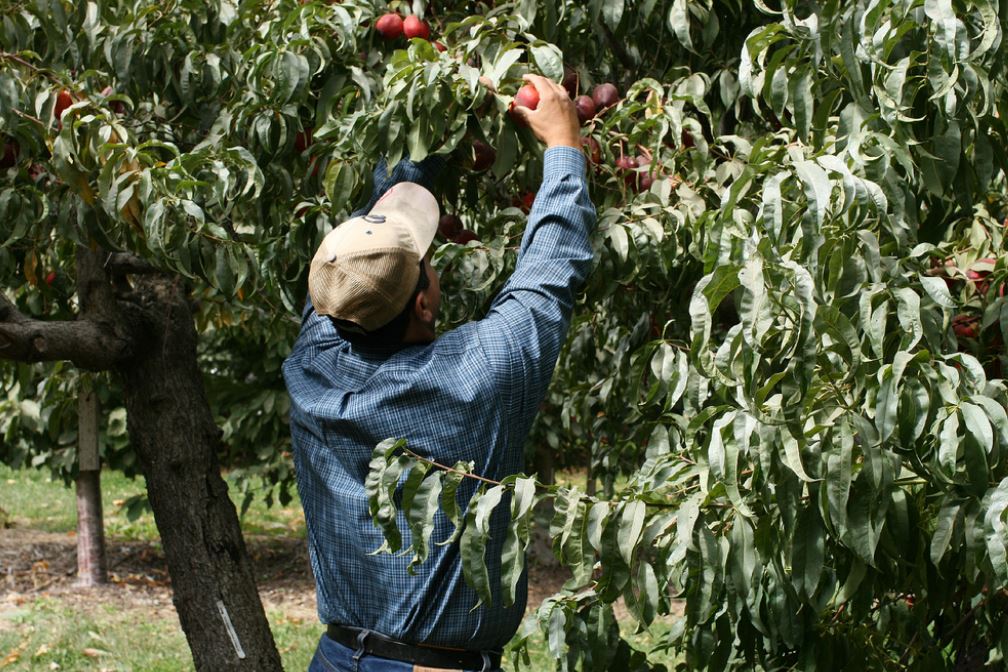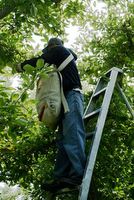Dehydration. Heat stroke. Asthma. Broken bones. Chronic pain.
These are a few of the issues faced by Latino farmworkers in Washington state who risk their health – and occasionally their lives – to ensure our shelves are stocked with the fresh produce that keeps us healthy. Some farm workers are especially vulnerable because they don't speak English and don't commonly know how to protect themselves in the workplace.
"If we don't take care of our farmworkers, who's going to do that work? How are we going to get fruits and vegetables?" says Elizabeth Torres, an educational outreach specialist in Granger, WA, who grew up in a family of farm workers.

Torres works with a non-profit agency and a local radio station that partner on research and health promotion campaigns with the Pacific Northwest Agricultural Safety and Health (PNASH) Center, housed within the School of Public Health's Department of Environmental and Occupational Health Sciences. She says she frequently hears about a wide range of injuries, including falls from ladders that result in broken legs, twisted ankles and sore backs.
Protecting and improving the health of agricultural workers through research and outreach is a key mission of PNASH, which opened in 1996. It is one of 10 centers across the country focused on research, education and prevention/intervention programs in agricultural industries. Funding comes largely through grants from the National Institute for Occupational Safety and Health (part of the US Centers for Disease Control and Prevention), US Environmental Protection Agency, and the Washington State Medical Aid and Accident Funds.
PNASH officials cite the need to support solutions – such as labor-saving technology, legal status, and worker training – that ensure a sustainable, year-round workforce for agriculture, a major industry in Washington state. "In occupational safety and health, we know that practical and sustainable solutions can only be developed at the workplace and with the active participation of workers, managers, and owners," says Professor Richard Fenske, PNASH director. "Our success is largely due to efforts to work closely with all stakeholders."
Here is a sampling of PNASH's recent and ongoing work:
Pesticides
Certain pesticides have been linked to a wide range of human health hazards, including acute poisonings, eye and skin irritation, and longer-term neurological damage and cancer. Workers can bring home traces of chemicals on their clothing and shoes. "Many people weren't aware that they had to take their clothes off before going into the house," says Torres, who works with El Proyecto Bienestar (the Well-Being Project) and Northwest Communities' Education Center, which runs KDNA-FM, a Spanish-language radio station. "You don't see it, but you pick it up like dust and bring it home. That affects the health of our kids."
Besides conducting numerous studies on pesticides over the last two decades, PNASH has developed a guide, "Practical Solutions for Pesticide Safety." It's available in English or Spanish and contains advice on everything from how to safely mix and apply pesticides to ways to separate work shoes from family space in cars and homes. The project partnered with pesticide handlers, orchard managers, and educators. "We really wanted the guide to speak to the people who use it," said Kit Galvin, senior industrial hygienist for PNASH. "Part of the guide's appeal is that it is filled with farm-based and tested solutions as well featuring the farmers and their stories about how they came up with their solution." The center also is developing a kit for educators who conduct hands-on training.
Ladder Falls

While pesticides are everywhere and their effects can be hard to detect over the long term, falls from ladders are the greatest risk to those who work in orchards, according to Peter Johnson, an associate professor of Environmental and Occupational Health Sciences who studies the ergonomics of apple production. Orchard workers can easily miss a step or lose their balance as they climb up or down, he says, and pickers have the additional burden of using ladders while wearing heavy bags of fruit. Fruit pickers frequently suffer from low back and shoulder pain.
Johnson, Galvin, and their colleagues also are studying a relatively new technology that allows workers to collect more fruit more efficiently. It's a self-steering harvest assist machine where pickers stand on raised platforms adjusted to different heights. Modern orchard design enables these machines to easily move up and down tree rows while workers pick fruit from the "sweet spots." Mobile platforms account for about 5 percent of all production in orchards, according to Johnson; the rest is still done by ladder.
So far, studies have found that heart rates during work periods were about 30 percent lower for platform pickers compared to those on ladders. This is likely because they no longer need to climb up and down ladders and carry heavy apple bags while walking to bins for unloading. Platform workers also self-reported lower levels of whole body, shoulder, and back fatigue. "On the whole, the platform appears to be more beneficial for the orchard workers," Johnson says.
Heat-Related Illnesses
While orchard work occurs year-round (winter pruning, for instance), summer brings the added risk of heat-related illness. It's not just the 90-plus-degree temperatures outside, but the exertion of the workers, who generate heat that their bodies at times cannot cope with, explains June Spector, assistant professor of Environmental and Occupational Health Sciences. Spector recently completed a two-year pilot project on heat-related illnesses. Potential risks to agricultural workers include inadequate hydration and the type of clothing worn, such as dark, layered clothing.
"When people are working by piece, you tend to eat less, drink less. You don't have time to take care of your personal health." - Elizabeth Torres
Another potential risk is getting paid by the amount of fruit that's picked, rather than by the hour. Under Spector's guidance, Kristina Blank (MPH '14) conducted research on this issue for her Master's thesis. One hundred agricultural workers were surveyed about their work, hydration, and cooling practices. Blank and her colleagues found that workers paid a piece-rate wage reported exerting themselves more than hourly workers and were four times more likely to report symptoms of heat-related illnesses. Says Torres, who facilitated the surveys, "When people are working by piece, you tend to eat less, drink less. You don't have time to take care of your personal health."
Sexual Harassment and Violence
For women in the fields (and some men), there's the added risk of sexual harassment. Victoria Breckwich Vásquez, director of community engagement and education for PNASH, says one-fourth of all agricultural workers in the US are women, and 75 percent or more have experienced sexual harassment at some point in their working lives. Vásquez says it's often perpetuated by those in power, such as supervisors.
A one-year PNASH project, supported by the Washington Medical Aid and Accident Funds, produced resource wallet cards with information on protection and what to do in case of harassment. It also included an educational radio drama that aired 60 times on KDNA featuring the stories of women and a play that has been performed at large health fairs. A training video is in the works with the Washington Growers League, a group with more than 400 growers. "There's nobody else doing this work in the entire Yakima Valley," says Vásquez, who is now advising Oxfam to develop a broad, national initiative to eliminate sexual harassment in agriculture. "It's not just a legal issue, but a workers' rights and health and safety issue."
Some other new and ongoing PNASH projects :
- An assessment of the effectiveness of high-efficiency particulate air (HEPA) filters in the homes of children with asthma who live near farms;
- Understanding injury risk factors for Filipino migrant workers in the Alaska fishing industry;
- Studying the health risks for migrant workers in the logging industry in Oregon and the Olympic peninsula.
- A study of the links between heat exposure, traumatic injury risk and productivity in agricultural workers.
Move information about these and other studies and the National Agricultural Center Programs can be found at:
https://depts.washington.edu/pnash/
http://www.cdc.gov/niosh/oep/agctrhom.html
